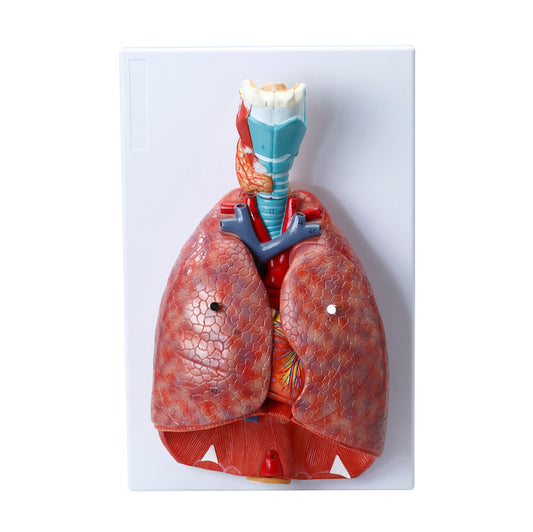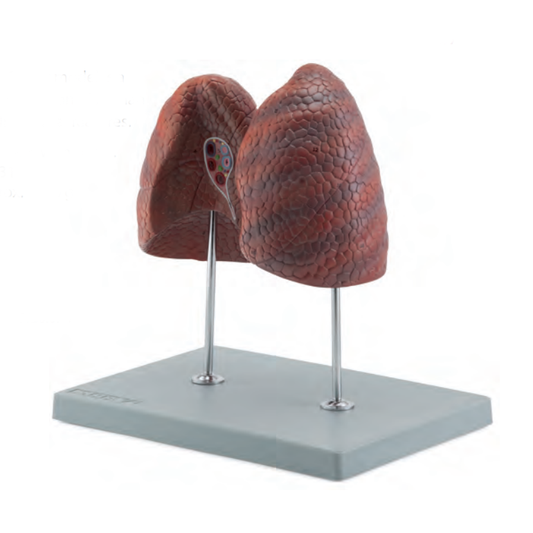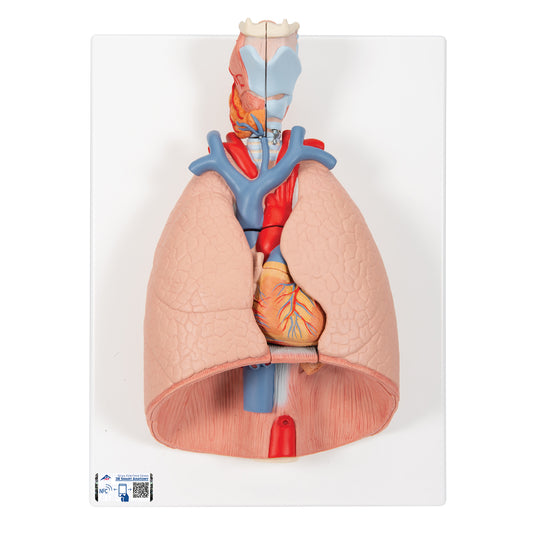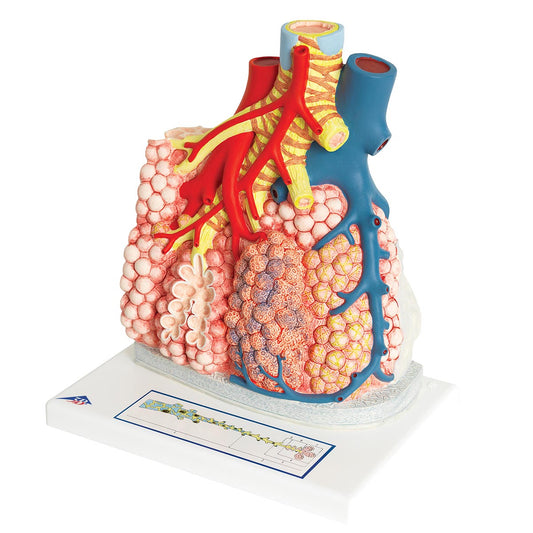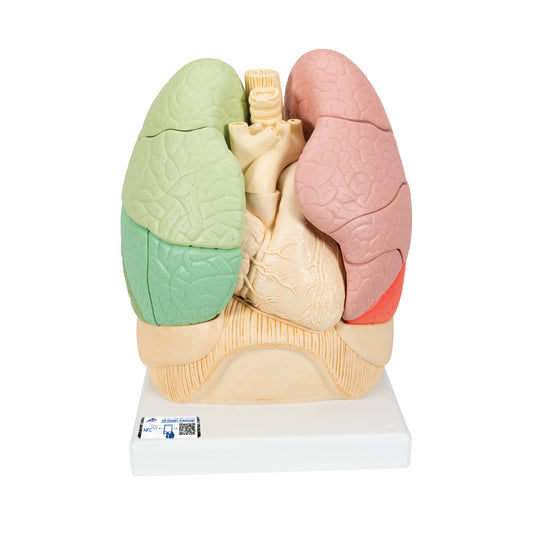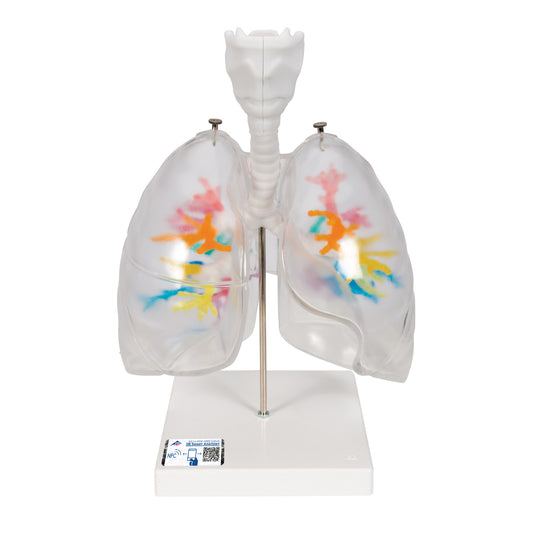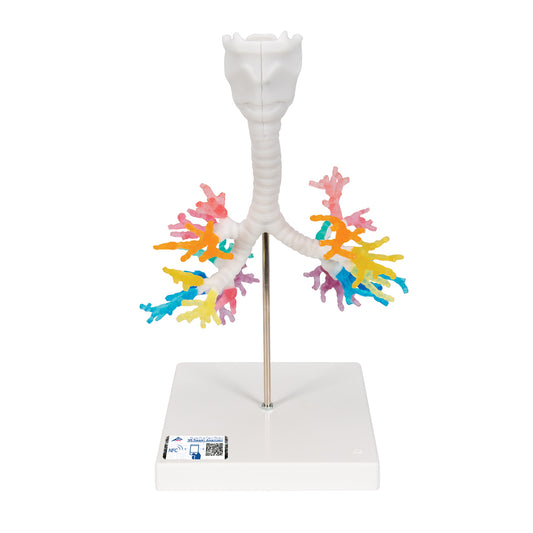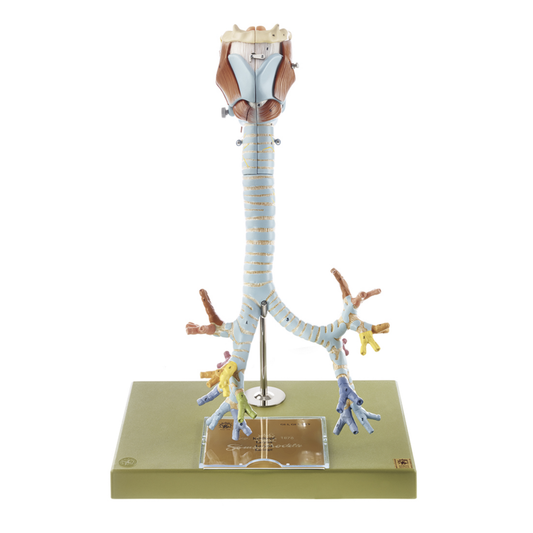Collection: The respiratory system
-


Practical and simplified model which shows the tissue changes in chronic bronchitis and asthma
Regular price €122,95 EURRegular priceUnit price / per -
Practical and simplified model showing narrowing of the airways in COPD
Regular price €155,95 EURRegular priceUnit price / per -
Complete and separable model of the respiratory system with relationships to other organs
Regular price €269,95 EURRegular priceUnit price / per -
Model of both lungs presented freestanding on a stand
Regular price €246,95 EURRegular priceUnit price / per -
Complete breathing system in 7 parts
Regular price €598,95 EURRegular priceUnit price / per -
Model of alveoli with surrounding structures
Regular price €350,95 EURRegular priceUnit price / per -
Lung model with heart and bronchi, divided into segments
Regular price €1.135,95 EURRegular priceUnit price / per -
CT bronchi with larynx 3D model via tomographic data with lungs
Regular price €811,95 EURRegular priceUnit price / per -
CT bronchi with larynx, 3D model via tomographic data
Regular price €558,95 EURRegular priceUnit price / per -
Anatomical model of the larynx with trachea and main bronchi
Regular price €1.457,95 EURRegular priceUnit price / per
Collapsible content
Read more about the product category here
In our selection of models of the respiratory system (airways), you can choose between a model that only shows the lungs, and a model that basically shows the entire respiratory system. There are also airway models focusing on the tissue changes in bronchitis, asthma and COPD. In addition, you will find a very practical and innovative model that can be used to demonstrate inspiration and expiration (breathing in and out).
Respiratory models/airway models are mainly used for understanding the anatomy of the airways as well as clinical aspects such as diseases, examinations and treatment.
Anatomically speaking, the respiratory system/airway includes many anatomical structures. The air/oxygen/oxygen is taken in via the nasal cavity and oral cavity. The air then passes through the pharynx and throat, after which it reaches the trachea. The majority of these tissues/organs are not located in the chest cavity/thorax. The trachea divides into main bronchi, after which these divide again into smaller airway branches in the lungs called bronchi and bronchioles (or bronchi and bronchioles). At the end of the bronchioles are the alveoli, where gas exchange takes place. Oxygen/oxygen is absorbed into the blood, while carbon dioxide (CO2) is released into the air so that it can be excreted with the exhalation. Overall, the lungs can be divided into lobes and segments.
The breath/respiratory system can roughly be divided into inhalation and exhalation (inspiration and expiration), which are physiologically different. The breathing muscles are the diaphragm and muscles in the chest wall (costal muscles).
During inhalation, the muscles create a negative pressure, because the diaphragm contracts and the contents of the abdomen are compressed a little, and because the rib muscles move the chest a little up and out. All this expands the lungs so that the pressure drops and therefore becomes lower than the surrounding air. This draws air into the airways.
Exhalation, on the other hand, takes place when the muscles relax. In this way, the chest and lungs are reduced so that they create an excess pressure. This results in the air being passively forced out of the lungs. That is that inhalation is an active process, while exhalation is primarily a passive process.
In each breath, approximately 0.5 liters of air pass in and out of the lungs (this is called the tidal volume).
You can also calculate other volumes such as TLC, FVC and FEV1. In a lung function test (spirometry) such volumes are calculated - for example when examining shortness of breath and organizing treatment (for example in COPD).
Clinically, the airway models can be used to understand lung diseases and other diseases in the chest cavity.
These can be, for example, obstructive diseases such as COPD and asthma as well as other diseases such as blood clots in the lungs, bronchitis, pneumothorax and lung cancer/metastases in the lungs.
The larynx functions as both an airway and a tone generator for the voice. See possibly also our models of the throat (incl. trachea) in the subcategory "Ear-nose-throat models". Here you will find, for example, this throat model which can be separated and this enlarged throat model.

A window to a world of anatomy
Whatever you're looking for
Then we can procure or produce it. eAnatomi is more than just a retailer of existing products. We have our own development department, where we create unique and original products that are used for training, guidance and inspiration.

19 years of anatomy
A safe transaction
For 19 years I have been at the head of eAnatomi and sold anatomical models and posters to 'almost everyone' working with anatomy in Denmark and abroad. When you do business with eAnatomi, you do business with me and I personally guarantee a safe transaction.
Christian Birksø
Owner and founder of eAnatomi
Latest blog news
View all-

Dermatomes and cutaneous innervation areas for ...
The anatomy of the nervous system is complex and involves a finely meshed network of nerve pathways that transmit sensory information from the skin to the brain. To best understand...
Dermatomes and cutaneous innervation areas for ...
The anatomy of the nervous system is complex and involves a finely meshed network of nerve pathways that transmit sensory information from the skin to the brain. To best understand...
-

2 meter tall anatomy figures - we call it anato...
For more than a decade, eAnatomy has produced our own anatomical illustrations, performed by the best illustrators. Where most illustrations are used on classic printed media such as posters, selected...
2 meter tall anatomy figures - we call it anato...
For more than a decade, eAnatomy has produced our own anatomical illustrations, performed by the best illustrators. Where most illustrations are used on classic printed media such as posters, selected...
-

Anatomical Chart Company - changes the format
Anatomical Chart Company har i 2023 besluttet af udfase papirvarianten for fremover kun at levere den let laminerede version med ringhuller. Dette betyder at det ikke længere bliver muligt, at...
Anatomical Chart Company - changes the format
Anatomical Chart Company har i 2023 besluttet af udfase papirvarianten for fremover kun at levere den let laminerede version med ringhuller. Dette betyder at det ikke længere bliver muligt, at...





